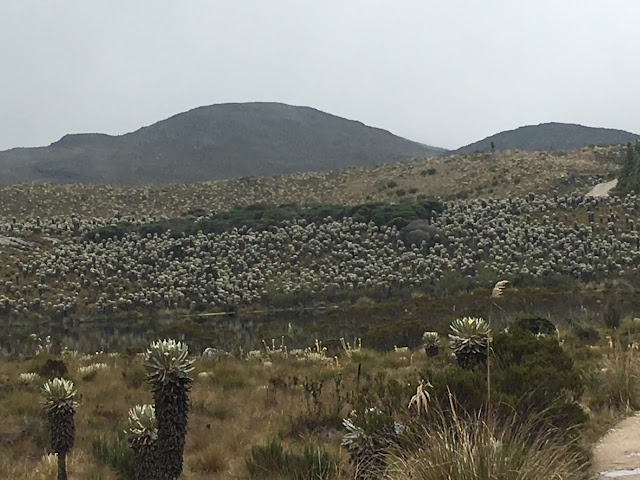Socio-ecological tensions, farming and habitat conservation in Guantiva-La Rusia
Highlighting the Cabot Institute’s commitment to growing the evidence base for water-based decision making, Dr Maria Paula Escobar-Tello (Co-Investigator) and Dr Susan Conlon (Post Doctoral Research Assistant) introduce the social science component of an exciting three-year project called PARAGUAS, an interdisciplinary collaboration between UK and Colombian researchers to investigate how plants and people influence the water storage capacity of the Colombian Páramos…
In June 2018, the Natural Environment Research Council (NERC) and the Arts and Humanities Research Council (AHRC) jointly awarded funding to five UK projects under the Newton-Caldas funded Colombia-Bio programme. The Colombian Department of Science, Technology and Innovation (Colciencias) subsequently awarded funding to 24 smaller Colombian projects under the same programme. PARAGUAS – How do the Páramos store water? The role of plants and people” is one of the five UK-funded projects.
 |
| Páramos are crucial for the livelihoods and wellbeing of millions of people (Photo © María Paula Escobar-Tello, University of Bristol) |
Crucial source of land and water
The páramos are tropical mountain wetlands found between 3000m and 4500m of elevation in the Andes. Known for their extreme water storage and regulation capacity, they generate exceptionally high and sustained water supplies to farmland, settlements and cities downstream. They are also an important repository of biodiversity. Páramos have been historically inhabited; first by pre-Colombian indigenous communities and nowadays by heterogeneous campesino communities who depend on them as a primary source of water crucial for their livelihoods and wellbeing. In the last few decades, several political, economic and armed conflict dynamics have pushed the agricultural frontier to increasingly higher elevations. The combined pressure of land use and climate change has already degraded many páramo areas and their potential demise has generated widespread concern across all levels of governance in Colombia, as well as within the NGO sector and research community.
Growing tensions in water conservation
A diversity of actors – government, NGO, community organisations, farmers – are interacting in the conservation of water in the Guantiva-La Rusia páramo, each with their own knowledges and understandings of the water storage function of the páramo, as well as contrasting views on who should benefit from this function and on the political economy of conservation efforts. Our team began to explore two sets of dynamics where these contrasting views were manifest during a pre-fieldwork campaign in January 2019.
In the first dynamic, local populations experience national and regional conservation efforts to address land and water degradation through the delimitation of the páramos – a controversial ongoing land management process whereby government authorities seek to map the areas they believe should be conserved to protect the páramos. One approach in these new land management policies and plans is to extend national park land under protection through land acquisition, which overlaps with complex pre-existing land ownership arrangements. In addition, the Ley de Páramos 233, 2018 (Páramos Law 233) prohibits farmers from carrying out productive activities on formerly-used land, which is now defined as páramos by authorities, and tasks local authorities with negotiating with farmers and supporting them in finding alternative economic activities. While this ban may sound ecologically necessary, multiple actors question the processes that have defined the páramo borderline for several reasons including its implications on farmers’ livelihoods, identities and ecosystem knowledges.
In the second dynamic, water conservation policies and plans prioritise the channelling of water from the páramos to the aqueducts that supply the populations downstream through land purchases that lead to changes in land use and the piping of springs and streams. These processes are equally contested and have led to community-level forms of organisation, representation and resistance; as well as to multi-scale and multi-issue conflicts between different campesino sectors; between local, regional and national-level political and environmental authorities; and between different discourses about environmentalism and modernisation.
Our project goals
As the social science component of PARAGUAS, we want to explore these different sets of socio-cultural and political tensions. We will do this by investigating how and why land and water use has changed in the Guantiva-La Rusia páramo and how this is related to public policy decisions that have shaped (or not) how local páramo inhabitants, particularly crop and livestock farmers, interact currently with the páramo through their day-to-day farming practices. Our aim for this part is to expose lesser heard voices in the conservation debate and listen to how local inhabitants articulate their understanding of the water regulation function of the páramo.
We are busy preparing for the first round of fieldwork in May 2019 and are designing our methodology of interviews, focus groups and digital storytelling techniques in close collaboration with our colleagues at Loughborough University. Watch this space for further updates!
This blog is written by Cabot Institute members Dr Maria Paula Escobar-Tello nd Dr Susan Conlon from the School of Veterinary Sciences at the University of Bristol.
 |
| Dr Maria Paula Escobar-Tello |






